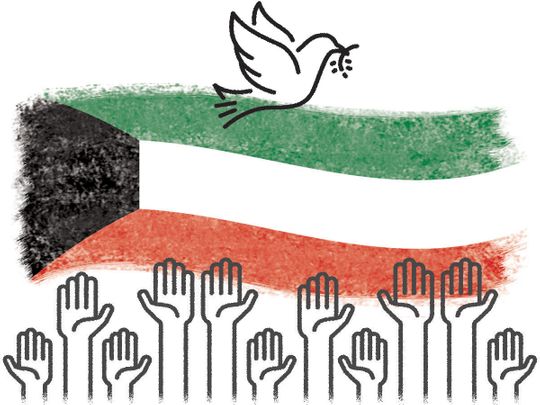
On 7 August 1990, an American delegation, led by then Secretary of Defence Dick Cheney, walked into an urgent meeting with Saudi Arabia’s King Fahd Bin Abdul Aziz. The meeting would be remembered decades later as the one that reshaped the partnership between the Gulf Arab states and the United States.
Five days earlier, on August 2, the Iraqi army stunned the world by invading Kuwait. The unforeseen aggression by Saddam Hussain’s army on the smaller neighbour rattled the world, and US President George Bush Sr. vowed on the same night that the aggression must not stand.
The US administration decided to send hundreds of thousands of troops to stop Saddam and liberate Kuwait. But that decision was contingent on the consent of the Arab world particularly Saudi Arabia not only to move American troops to the region but also to rally an international coalition.
The kingdom, of course, along with the UAE and other Gulf states, were determined to defeat the invasion at all costs. “Our destiny is one, if Kuwait goes, Saudi Arabia will go too,” King Fahd is famously quoted as telling the American delegation.
Operation Desert Storm
Eventually, an 800,000-strong international coalition, from 34 countries, was assembled and Operation Desert Storm was unleashed. On January 17, 1991, the coalition began an air campaign, in which Saudi and Gulf pilots took part alongside their American counterparts, flying thousands of sorties. Weeks later, a coalition land operation drove the Iraqi army out of Kuwait. On the night of February 26, Kuwait was free again.
Kuwait few days ago celebrated its 60th National Day and the 30th anniversary of the liberation. The invasion was one of the darkest chapters of the modern Arab history.
The liberation meanwhile represented one of the most successful joint actions between the US and Gulf states. Ever since, the two sides would build on that strategic partnership to ensure peace and security in an otherwise restless region.
In the last three decades, the US deployed veteran diplomats to this region who understood the dynamics of the Middle East. They knew what was at stake and worked with their Gulf colleagues to keep the threats at bay and grow the chances of peace.
It has been working well so far — with probably one slightly different approach under former President Barack Obama whose perplexing fascination with Iran led him to ignore America’s real partners in the region.
His nuclear deal with Tehran in 2015 failed to satisfy most of the elements such a deal would naturally address, especially the continuing belligerent policies of the Iranian regime, which are widely considered as the cause of most of our region’s ills. His inaction, and reluctance to heed the advices of America’s friends, led to the bloody disasters in Syria, Libya, and Yemen.
Former President Donald Trump tried to fix some of those fatal mistakes and the US-Gulf partnership seemed to have been put again on the right track. But he was a one-term president.
However, in the past month, as President Joe Biden took office, we have seen some confusing signs from the White House or confused to be precise, that cast doubts about the way the new administration views the American partnership with the Gulf. Many are hoping that we are not onto another Obama approach to the region.
Challenges ahead
The US and the Gulf region both are faced with the same three challenges. Firstly, a failure in checking Iran’s pursuit of nuclear weapons would trigger a nuclear arms race in the region and most probably a war between Iran and Israel — actual and by proxy.
Secondly, the continuing instability in Iraq, Lebanon, Syria and Yemen will have a ripple effect on the region that could undermine the security of the Gulf region and probably give rise to new terror groups and at the same time empower Iran’s proxies in those countries.
Finally, the threat of terrorism. Terror groups may have been on the run in the past few years but are not completely out of the picture. Recent attacks in Iraq, Afghanistan and Yemen show that these groups are just laying low waiting of an opportunity to strike.
Facing those detrimental challenges require an extensive cooperation between the US and its Gulf partners. President Biden not only needs to weigh in on those challenges but also to learn from the history of the US-Gulf relations to formulate a successful Middle East policy.
Past US presidents recognised that fact, which enabled them to help build a political and security structure in the region that benefited the two sides and contributed to the stability and prosperity of the Gulf region.
That approach was critical when Iran, following its 1979 Islamic revolution, attempted to ‘export’ its religious ideology to other parts of the region and undermine regional states. It was successful when Iraq invaded Kuwait. The partnership was vital to win the war on terror post September 11 attacks on New York.
It is also central to the stability of the oil market as it is important in planning new drive to revive the dormant Middle East peace process. Those are few examples of successful policies made possible by the US — Gulf parentship. They are actually historic lessons for President Biden, and any other US official, to learn from.
There is no US interest in rocking the boat. Just think of what kind of a region we would be living in today had President Bush Sr. balked when Saddam’s army invaded Kuwait 30 years ago!



_resources1_16a45059ca3_small.jpg)




